Abstract
The deterioration of stone heritage in urban environments is mainly the product of sources of air pollution like vehicular traffic and domestic heating. The results of these phenomena usually manifest as acid rain and particulate patinas, acting on the surface of stone monuments to form the so-called “black crusts”, a typical stone degradation product, mainly composed of gypsum. The aims of this study were to investigate the extent of these phenomena on the decorative apparatus of the frontal façade of Gesù Nuovo Church, in the historical centre of Naples (Italy). Preliminary diagnostics consisted of XRD and FTIR to analyse the composition of stone materials and inquire about previous restorations. The chemical characterization of black crusts was performed, using a diverse array of techniques, to highlight how different compounds are distributed along a vertical gradient and considering the proximity of specific sources of pollution (vehicle engine ignition, incense combustion, domestic heating products). Finally, molecular biology techniques were employed to identify the organisms which typically dwell in this formation and speculate about their contribution to the degradation of stone.
1. Introduction
The preservation of cultural heritage in urban contexts presents a plethora of complex challenges. Buildings and sculptures found outdoors in densely populated cities, especially in the proximity of heavily inhabited areas or industrial complexes, are affected by a broad range of chemical pollutants, from gaseous nitrogen and sulphur oxides to hydrocarbons, ozone and particulate matter [1].
The main sources of pollution in heavy-trafficked urban areas usually consist of the byproducts of domestic heating and fuel combustion, such as polycyclic aromatic hydrocarbons (PAHs), sulphur dioxide and the oxidated forms of nitrogen (NO, N2O, NO2) [2]. Such compounds, known as primary pollutants, spread in the lower atmosphere and, interacting with water vapour, react to form sulphuric and nitric acids [3]. This chain of events constitutes the well-known and heavily discussed phenomenon of acid rain: among the most serious threats to the preservation of outdoor stone artefacts, this acidic precipitation provokes the slow degradation of exposed cultural heritage through the corrosion of carbonate stones and the consequent deposition of calcium (Ca2+), carbonates (CO32−) and sulphates (SO42−) [4].
Another prominent pollutant affecting the conservation of outdoor cultural heritage is represented by hydrocarbon deposits. PAHs (polycyclic aromatic hydrocarbons), fine dusts and vegetal debris are carried around by winds and convection currents, subsequently depositing on the surface of exposed artefacts, slowly accumulating on spots with better retention properties to eventually produce crusts of various colours and thickness [5]. These grey and black crusts represent not only a sensible chromatic alteration in the artwork original semblance, but they also work as catalysts for other chemical reactions [6]. Furthermore, these formations constitute an ideal environment for the colonization of microorganisms like bacteria and fungi and the consequent development of polysaccharidic biological patinas, typically known as biofilms. Biological entities may harm the structure of stone materials mechanically by penetrating the surface, subsequently provoking the detachment of superficial layers (e.g., exfoliation of plasters); they can also interfere with stone in other ways by releasing organic acids that contribute to the chemical corrosion of the surface [7]: these species, such as oxalic and acetic acids, heavily tamper with the composition of stone surfaces, affecting the integrity of calcium carbonate layers to produce calcium oxalate and calcium acetate.
Moisture, both superficial and interstitial, constitutes a crucial factor for the development of deterioration phenomena affecting outdoor artefacts. For instance, patinas with higher water retention are generally more prone to colonization by biodeteriogen microorganisms and, consequently, to chromatic and physio-chemical alterations [8]. Furthermore, water is among the main causes of erosion, both through mechanical impact and wetting–drying cycles [9], and participates in the formation of acidic compounds when reacting with primary pollutants [10]. Stone materials, typically composed of carbonates and silicates, have naturally high water retention due to their hydrophilic surfaces [11].
Among the most common forms of degradation on outdoor stone artefacts are conspicuous dark patinas, usually referred to as “black crusts” in the context of stone conservation. This phenomenon, amply common on outdoor stone heritage, is mostly related to the presence of condensation water and high concentration of specific species of air pollutants [12]. Black crusts are usually composed of multiple layers [13], constituting the product of the interaction of carbonate stone with sulphuric air pollutants, as when calcite reacts with SO2 to form gypsum (CaSO4·2H2O) [14]. What initially constitutes a generally porous structure, in time, begins to narrow and contract, completely changing its mechanical behaviour. These crusts also contribute to an alteration in stone materials by virtue of their colour, as darker patinas like these tend to absorb more solar radiation, heating up more rapidly and provoking the dilation of the underlying surface [15].
As the need to develop strategies to ensure a thorough characterization and the efficient monitoring of the longevity of restoration interventions arises, a variety of diagnostic techniques are being employed in order to face any scenario with an array of context-specific instruments. To examine the effectiveness of some of these approaches for the monitoring of stone deterioration, we selected the sculptures embellishing the front façade of the church of “Gesù Nuovo” in Naples (Figure 1 and Figure 2), a site located in the middle of the historic centre, profoundly immersed in the thick fabric of the city [16], and therefore prone to deterioration caused by urban air pollution (Figure 3).
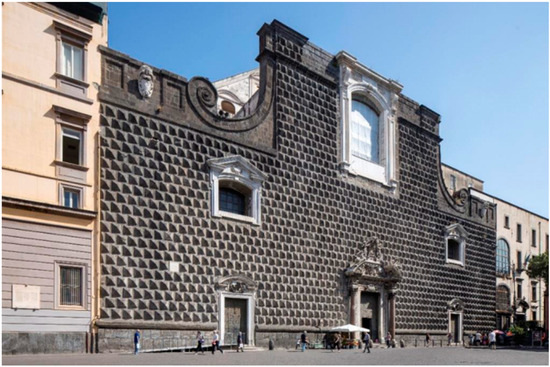
Figure 1.
Façade of the Gesù Nuovo Church, as seen from beside Immacolata’s Obelisk.
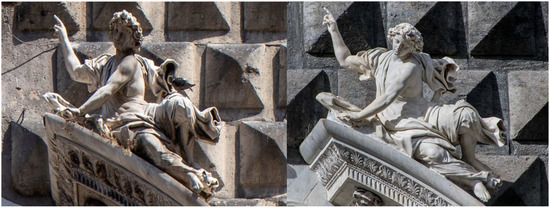
Figure 2.
A statue of an angel, among the four adorning the upper part of the portal of the church. Photos taken before (left) and after (right) the 2022 restoration intervention.
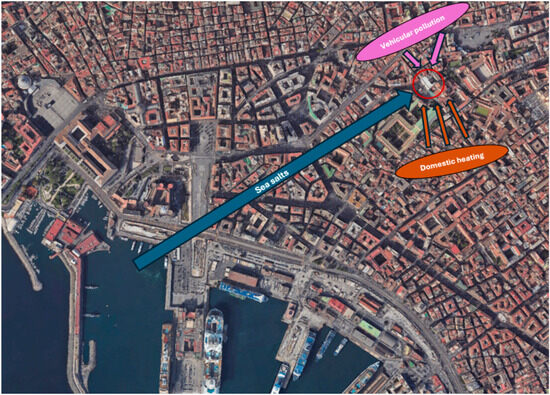
Figure 3.
The main environmental sources of degradation in the context of Piazza del Gesù. (Map data: Google, ©2024 Airbus, CNES/Airbus, Landsat/Copernicus, Maxar Technologies).
The church faces a square which has been heavily trafficked for most of the XX century, even being used as a parking lot despite its historical relevance, only becoming a pedestrian area in the last few decades. Being immersed in the centre of the old town, it is also surrounded by a large although fragmented residential area. Given these circumstances, the deterioration phenomena are nonetheless almost all the result of both intense vehicular pollution and domestic heating, as well as biomass burning, featuring local restaurants and harbour activities that contribute to the accumulation of NO2, particulate matter and hydrocarbons [16,17,18,19].
This condition is common to other historical buildings and churches located in the urban areas of Naples and in similar historical centres; consequently, the conclusions that we can draw can also be applied to other cases of similar features.
In the early 1980s, the church’s façade underwent a series of restoration interventions, with the purposes of consolidating the marble, recently damaged by bombardments and seismic activity, and cleaning off the crusts formed in previous years. Taking this into account, this work also offers the chance to assess the dynamics of degradation phenomena on stone heritage in a contained amount of time, from the early 1980s to the early 2020s. In addition, the results presented and discussed herein on the chemical and biological characterization of deposits collected from this site were the reference for the choice of the restoration strategy applied on the Gesù Nuovo façade in 2022 (Figure 2).
The physical, chemical and biological assays selected for this case study, among the ones commonly employed for the study of stone degradation, were employed to characterize and quantify the impact that pollution has had on artefacts. This constituted an effort to reconstruct the peculiar dynamics of the urban fabric that might influence the integrity of stone materials, highlighting the many complexities of cultural heritage conservation in outdoor urban areas [20].
2. Materials and Methods
The diagnostic techniques selected for this work were chosen to offer preliminary insights into the features of the stone monument and the phenomenology of its degradation (Figure 4). XRD was used to characterize diverse mineralogic components; optical microscopy was used to obtain a deeper look into various deterioration phenomena, as well as the microscopic structure of diverse formations; FTIR aided in further investigating the nature of stone and the materials used in previous restoration interventions. Ionic chromatography and other chemical characterization techniques used for the quantification of metals and hydrocarbons were employed to understand the nature of the formations and inquire about the potential sources.

Figure 4.
The sampling spots chosen for each technique: the first row shows the four sampling spots selected for X-ray diffractometry, from D5 (left) to D8 (right); the second row shows the three spots selected for Fourier Transform Infrared Spectroscopy (F4, F3 and F1); the third and fourth rows contain some of the sampling spots used for the characterization of chemical deposits (from left to right, third row: C1, C7, SC and SCI; from left to right, fourth row: C4, C6, C5 and C3); the fifth and sixth rows contain the sampling spots from which biological samples were collected (from left to right, fifth row: C4, C6, C8 and C9; from left to right, sixth row: C10 and C11).
Some of the sampling spots were selected to delineate a hypothetic vertical gradient of the distribution of chemical species along the façade of the church. Another element of choice for the selection of sampling spots was the visible presence of conspicuous formations, coloured patinas and black crusts. Some of the samples were collected from a selection of spots located on the portal, as this represented the portion of the façade most affected by degradation phenomena, probably related to the frequent combustion of incense, alongside vehicular smog produced by engine ignition: such is the case of samples SC, SI, I2, SM and SCI. The latter samples were subjected to polarography in order to analyse and quantify some traces of metals. A comparison among the obtained data was carried out with this speculative distinction in mind: samples collected at various heights on the church’s façade were used to evaluate urban pollution on the vertical axis (hydrocarbon concentration was taken into account for these samples), while most of the samples from the portal were separately compared to inquire about the effect of incense combustion (metal concentration was considered for these samples).
Finally, molecular biology techniques were carried out to identify the organisms involved in the phenomena of biodeterioration and eventually find a link between the presence of these organisms and the chemical features of some of the deposits.
Sampling was carried out with the help of restoration staff; black crusts were mechanically collected, and particular care was taken to avoid sample contamination from the substrate (deposits were detached, paying attention to not affect the marble surface). Samples for microbiological analyses were collected by means of sterile swabs and scalpels.
The selection of sparse sampling spots was ultimately conducted in a way to make it as representative as possible of the different phenomena of degradation and of the diverse formations all over the façade; the sampling campaign was nonetheless equally influenced by the availability of scaffoldings used for the restoration works, present at different heights.
2.1. Description of Site and Diagnostic Investigations
2.1.1. Description of Site and Sources of Degradation
The church of “Gesù Nuovo” is found in Piazza del Gesù (Naples, Italy), at the western end of Decumano Inferiore street. Formerly serving as a household for the noble family Sanseverino, it was later reinstated as a church when it was acquired by the Jesuit order in 1584 [21]. The façade facing the square features a peculiar pyramidal motif; the portal is adorned with a pair of red granite columns, originally transferred from Apollo’s temple, along with a marble composition consisting of two pairs of angels, one of which carries the Jesuit order emblem. During the second world war, the square was bombarded, causing non-negligible damage to the decorations; furthermore, in the latter part of the XX century, the earthquakes of 1962 and 1980 also constituted a major contributor to the statues’ degradation.
Apart from the mechanical damage, most of the degradation of the façade is the product of the interaction of various environmental factors: among these, sea salt deposition [22], carried by the wind from the nearby sea, is one of the most influential natural sources of deterioration. As the square in front of the church was used until the middle of the 1990s as a parking spot for buses and cars, vehicular pollution, both recent and historical, probably constitutes the most influential anthropic source of pollution [23], alongside the products of domestic heating [24] and restaurant-related combustion activities (Figure 3).
Another slightly different form of degradation is constituted by incense combustion, which happened regularly on festive days above the portal of the church, and it manifests as the accumulation of particulate matter and metals on stone surfaces [25].
2.1.2. X-Ray Diffractometry
XRD was used to obtain semiquantitative information about the mineralogic components of the crusts and stone samples. This technique is semi-destructive, as it requires a small portion of the sample to be pulverized and subjected to testing. An X Miniflex Rigaku X-Ray diffractometer (Rigaku Americas Holding Company, The Woodlands, TX, USA) with a cobalt tube was employed for the analysis, operating at 30 KV/15 mA with a count time of 3600 s.
Four samples were selected for this investigation, two from marble stones and two from mortar materials (Figure 4). Before each measurement, a calibration process was carried out by using a quartz standard specimen to check whether the resulting peaks were consistent with the expected standard spectrum of quartz.
2.1.3. Optical, UV and IR LED Microscopy
The morphological structure of the substrates was investigated by employing three different microscopy techniques. The observation of the texture of the carbonate matrix, black crusts and biofilms was carried out with a DINO Lite AM2111 optical microscope.
A DINO Lite AD4113T I2V microscope was used to obtain UV and IR images on the same spots to highlight the luminescence of biofilms colonizing the substrate.
2.2. FT-IR Spectroscopy
Fourier Transform Infrared Spectroscopy was employed to analyse the chemical structure, functional groups and bonds of the compounds featured in the stone decorations above the portal of the church [26]. The analysis was carried out using a Nicolet iS10 Thermo Fisher Scientific FT-IR spectrophotometer, with a dried and sealed optical system and optical bench, equipped with KBr windows with a protective CaF2 coating.
The three sampling spots were chosen according to the differently coloured patinas they present: a grey patina (F4), a yellow patina (F3) and a whitish one (Figure 4). Prior to measurements, the instrument underwent a proprietary protocol of autocalibration by keeping the press lowered in order to check the cleanliness of the resulting spectrum.
2.3. Chemical Characterization of Deposits
The deposits and formations sampled from the decorations above the portal and the façade of the church were analysed using a diverse array of techniques. Analyses of soluble compounds were carried out using ion chromatography, while polarography was employed to quantify metal concentrations in the crusts found above the portal; finally, the overall concentration of hydrocarbons was measured through gas chromatography.
For the determination of chemical compounds, samples were pretreated to separate deposits from marble or piperno substrates; then, samples were ground to obtain a homogeneous powder.
From this material, a weighted aliquot was used to obtain the soluble fraction by placing it in a microwave extractor with 15 mL of ultrapure water for 1 h [27].
Solutions were filtered with filters of 0.2 µm pore size and analysed via ionic chromatography using a Dionex 1100 system, equipped for the simultaneous determination of anions (fluoride, bromide, chloride, nitrite, nitrate, sulphate, phosphate, formiate, acetate, oxalate) and cations (calcium, sodium, potassium, ammonium); a 3.5 mM sodium carbonate/bicarbonate solution and a 0.2 mM methanesulfonic acid solution were used as eluents for the determination of anions and cations, respectively.
A second aliquot was used for metal determination. Samples were mineralized into a PTFE vessel and treated with 4 mL of HNO3 (65%, Suprapur, Romil) and 2 mL of H2O2 (30%, Suprapur, Carlo Erba). The vessels were placed in a microwave extractor (Milestone Start E) and digested. After mineralization, solutions ware filtered on filters with a porosity of 0.2 μm and diluted with ultrapure water to 10 mL. Metal concentrations were determined using a polarographic system (Metrohm 797 VA Computrace) equipped with a multimode working Mercury electrode. A Ag/AgCl electrode was used as a reference and a Pt electrode as an auxiliary electrode. For calibration, the standard addition method was applied to limit matrix effects. This method allows for the determination of zinc, cadmium, lead and copper. Quality control and assurance for both ionic chromatography and the polarographic method were discussed in Chianese et al., 2019 [28].
Being a family of compounds, total hydrocarbons include all hydrocarbons existing in nature, regardless of the number of carbon atoms, their toxicity and dangerousness. Hydrocarbons (linear, branched, cyclic and aromatic) can be petroleum or biogenic, of animal and vegetal origin, with different molecular weights and chemical and chemical–physical characteristics.
In environmental chemistry, total hydrocarbons are the sum of the mass concentrations of two fractions expressible as n-hexane:
- -
- Extractable fraction (C10H22–C40H82).
- -
- Volatile fraction (C6H14–C10H22).
For the determination of total hydrocarbons, we performed chemical analyses of non-volatile hydrocarbons (extractable fraction) as reported in the Manual and Guideline MLG 75/11 of ISPRA “Procedure for the analysis of hydrocarbons >C12 in contaminated soils” and EPA 3545 [29].
The samples were mechanically pretreated with a Retsch PM200 ball mill for 5 min at a speed of 500 rpm. This is a necessary step to homogenize and reduce the sample’s size and, consequently, improve analyte recovery.
The extraction of hydrocarbons was carried out via the “Accelerated Solvent Extractor” (ASE) technique using the Dionex ASE 200 [30].
Approximately 2–3 g of sample, measured with a precision of ±0.0001 g, was inserted into 22 mL stainless steel cells. Chromatographic-grade hexane was chosen as the extracting solvent. The extraction operating conditions were T = 120 °C; P = 1500 psi; n° static cycles = 2.
The extract was eluted in SPE glass columns containing 2 g Florisil 60–100 mesh and 1 g of anhydrous sodium sulphate (in this phase, all polar compounds were adsorbed on Florisil). The obtained eluate was evaporated with nitrogen 6.0 using a Biotage TurboVap evaporator LV, to reduce the solvent amount to a volume of 1 mL.
To determine total hydrocarbons, we used the chromatographic technique with a gas chromatograph (AGILENT model 7820) equipped with a flame ionization detector (FID) and non-polar capillary column. Before performing the chromatographic analysis, a certified Merck standard of n-alkanes equal to C10–C40 was injected into the GC-FID.
A calibration curve was obtained using dilution starting from a certified standard from UltraScientific Italia constituted by a mixture of diesel fuel and lubricating oil without additives.
The sampling spots on the façade were selected taking into account the different kinds of pollutants and crust-like formations to investigate their contributions to degradation phenomena and inquire about location-dependant fluctuations in abundance. Almost all the spots (Figure 5) are found on the marblework above the portal, but a spot on the upper part of the façade was also collected to serve as a confrontation.
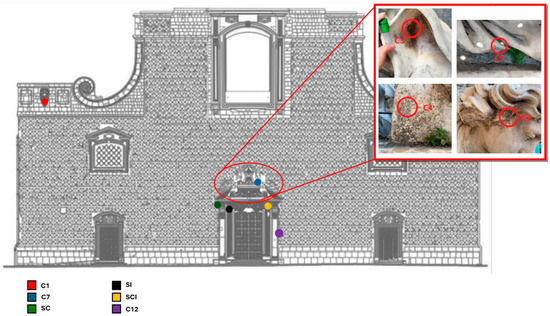
Figure 5.
Some of the deposits’ sampling spots: most of the points were selected on the decorations to be subjected to restoration and on the columns of the portal; to act as a confrontation, C1 was sampled from the upper side of the façade, several meters above. In the red square on the upper right, the sampling spots were chosen on the stone decorations above the portal.
2.4. Biological Analyses
The presence of microorganisms on the different sampling spots on the stone surfaces (Figure 4) was examined through isolation in specific growth media and molecular biology techniques.
The biological samples were collected using sterile swabs and scalpels and subsequently analysed through molecular techniques. DNA extraction was carried out using a Doyle and Doyle extraction protocol. Following PCR, molecular cloning was employed to greatly amplify two specific markers in order to gather a sufficient number of templates for Sanger sequencing. The 16S locus was selected for its diagnostic value in the identification of bacteria [31], while the 18S locus was similarly chosen to identify eukaryotic organisms [32]. The cloning vector utilized is the linearized pJET1.2/blunt vector, ideal for fragments ranging from 6 to 10 kb [33]. A CloneJet PCR Cloning Fermentas Kit was used for the cloning procedure, following the producer’s instructions. Finally, the obtained templates were put through Sanger sequencing, and the resulting sequences were launched against the GeneBank database, selecting only the highest scoring 100% identity matches for the identification results.
3. Results and Discussion
3.1. Diagnostic Investigations
3.1.1. X-Ray Diffractometry
The examination of the four samples produced a semiquantitative spectrum of the main minerals composing the various formations (Table 1). Quartz and calcite correspond, as expected, to the more abundant materials in every one of the considered samples. Nevertheless, a peculiarity emerges in the registered although less abundant presence of minerals like gypsum (CaSO4·2H2O) and feldspars (orthoclase, KAISi3O8; sanidine, (K,Na)(Si,Al)4O8) in samples B and C, which were gathered from two different kinds of mortars. The presence of such minerals might imply that the investigated mortars were actually older than thought, as the absence of modern cementitious materials excludes any possible recent intervention. Finally, iron oxides, specifically magnetite (Fe3O4) and hematite (Fe2O3), were found in traces in all the analysed samples; moreover, similar quantities of diopside (CaMgSi2O6), a mineral belonging to the pyroxene group, were found.

Table 1.
The results of the XRD analysis for each of the investigated spots.
3.1.2. Optical, UV and IR LED Microscopy
Observation through optical, UV and IR microscopy was employed, both before and after the restoration intervention, to observe the effects of consolidation and the cleaning off of patinas. It showed microscopic patterns consistent with some of the other analytic evidence gathered. Particularly, on the finger of one of the angel statues (Figure 6), particulate deposits were easily identifiable, resulting in the blackening of the stone texture. Other spots, such as the elbow, showed evident signs of microbial colonization, with some colonies spreading through the exfoliated layers of stone.
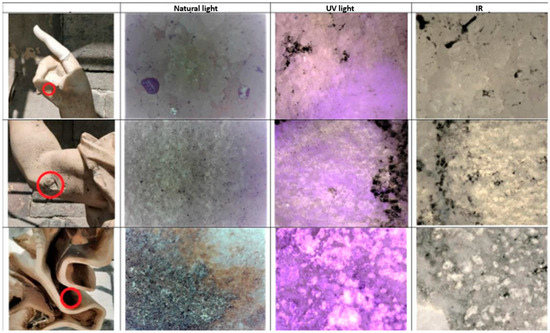
Figure 6.
Natural light optical microscopy (left, 125×), UV light microscopy (centre, 195×) and IR microscopy (right, 85×) conducted on some of the investigated spots.
Microscopical observation was also employed to verify and exhibit the results of the interventions: particularly, consolidation, cleaning and the results of biocide treatment were evident and consistent at the highest magnification.
3.2. FT-IR Spectroscopy
FT-IR allowed for the detection of previous protection and consolidation interventions, and on this basis, it was used on three spots presenting different patinas, all located on the piperno flagstones. Through this assay, it was possible to confirm that the restorations of the 1980s were not limited to cleaning procedures; it was evident, through the interpretation of the transmittance spectra, that besides the cleaning intervention, other materials were applied at the time in an effort to further consolidate the structure of the façade.
The whitish patina instead presented a more common abundance of carbonates and sulphates, probably associated with the deformations of calcite and gypsum (Table 1).The examination of transmittance intensity peaks (for example, the grey patina’s spectrum in Figure 7) showed that the grey and yellow patinas both express optical features signalling the presence of Paraloid, an acrylic resin commonly used for the consolidation of stone, glass and wood artefacts [34]. While the yellow patina is purer in this respect, presenting only resin, the grey one also showed the presence of volcanic materials, probably associated with tuff (Table 2).
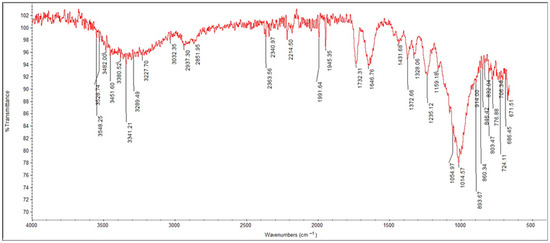
Figure 7.
Transmittance spectrum obtained through FTIR on grey patina.

Table 2.
Interpretation of FT-IR results for each patina.
3.3. Characterization of Deposits
3.3.1. Vertical Gradient of Chemical Species
The first comparison between sampling spots selected at different heights (C1—high; C7—medium; C12—low; Figure 8) shows how pollutants are distributed along the surface on the vertical axis. Analysing the percentage composition of the three samples, a difference in the presence of organic acids is observable: as an example, the sample collected from the highest spot of the church’s façade (C1, 16 m above ground) stands out because of the conspicuous presence of formiate (1.3922 ± 0.0195 mg/g), while the lowest spot (C12) presents the greatest amount of acetate (0.1268 ± 0.0011 mg/g). Among organic acids, oxalate was not detected in this group of samples; the only samples with a detectable concentration of oxalate were taken from the portal, as discussed below.
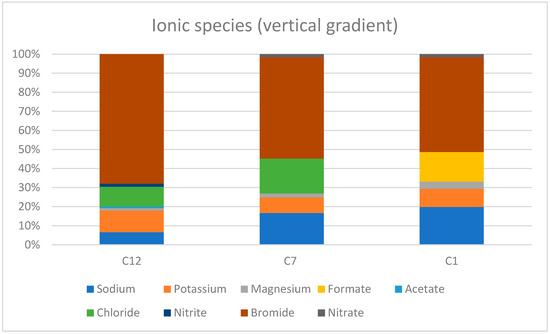
Figure 8.
Ionic species distribution (%) on the vertical axis of the church’s façade.
As observed, C7 and C12, collected 10 m and 6 m above ground, respectively, do not feature a comparable presence of organic acids; nonetheless, they differentiate from C1 because of the presence of chlorides at lower heights (C7: 3.0222 ± 0.0423 mg/g; C12: 1.831 ± 0.0201 mg/g). The central sampling point (C7) seems to be an accumulation point for some species such as sulphate, nitrate, chloride and sodium with the highest concentration reached at this height. Finally, the only species presenting a linear dependence from the height of sampling are bromide, nitrite and potassium with a negative trend and magnesium with a positive one.
In Figure 9, the concentration of hydrocarbons along the vertical axis is shown; their overall concentration was significantly lower at higher heights (0.027 ± 0.001 mg/g) when compared to the samples nearer to the ground (0.372 ± 0.005 mg/g) and was comparable to those at the intermediate height (0.0197 ± 0.001 mg/g). This observation is consistent with the consideration that the main source of these pollutants is represented by vehicular traffic, so it is admissible that at the lowest height, the impact of this process is more evident, also considering that the square in front of the façade was used for parking in the past, as discussed before.
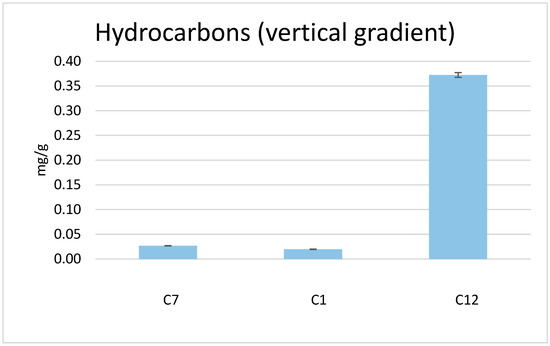
Figure 9.
Hydrocarbon concentration (mg/g) on the vertical axis of the church’s façade.
3.3.2. Comparison Among Ionic Compositions
Comparing the data obtained from the ionic chromatography of all samples (Figure 10), some peculiarities emerge. While most of the samples present a considerable amount of bromides, probably the product of stone erosion, the concentrations of organic acids differ considerably in different spots: most of the samples collected on the upper portion of the portal (SCI, SC, SI and SM) present a higher percentage of oxalate (SC, the one consisting of only the black crust, featuring the highest concentration at 4.787 ± 0.053 mg/g), while C6, collected from the patinas on one of the statues, features the highest concentration of acetate (1.132 ± 0.011 mg/g).
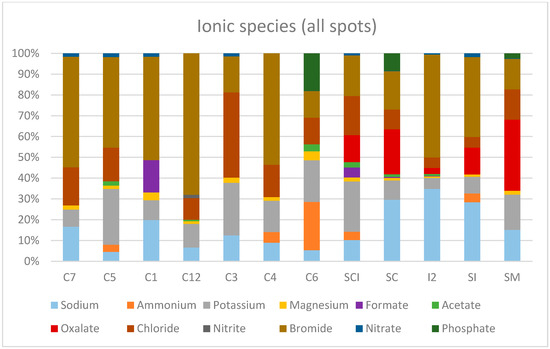
Figure 10.
Ionic species distribution (%) in all spots collected over the church’s façade.
C6 constitutes a peculiar specimen, as it also features the highest concentration of ammonium (7.771 ± 0.069 mg/g), phosphates (6.026 ± 0.090 mg/g) and potassium (6.713 ± 0.081 mg/g); these results match well with the presence of guano in this sampling point (the same observation can be made for the sampling point named SC).
Sodium and chloride present high variance among all samples: specifically, sodium shows some of the highest concentrations in the samples collected above the portal (SC, featuring a concentration of 6.528 ± 0.072 mg/g, and I2, with a concentration of 20.480 ± 0.287 mg/g), while chloride is found mostly on the samples collected on the statues (C3 presents the highest concentration for chloride at 9.335 ± 0.112 mg/g).
This observation is well explained considering that chloride may be dissolved in the marble pores and thus observed on its surface when damaged, as in this case.
Calcium and sulphate concentrations, shown apart from the rest of the data due to their high concentration values (Table 3), also present a trend of high variance in the analysed samples: C3 shows, in this case as well, the highest concentrations of 122.553 ± 1.471 mg/g and 441.284 ± 4.854 mg/g; these consistently high concentrations might be explained by the geometric nature of the C3 sampling spot which, because of its curvature, might constitute an accumulation point. Generally, a linear correlation between these species is not observed; this may mean that, apart from the common origin consisting of the generation of calcium sulphate, there are other processes contributing to their accumulation, as an example, those of sulphate from marine aerosols and calcium from stone or with a crustal origin.

Table 3.
Calcium and sulphate concentrations (mg/g) on all spots collected over the church’s façade. In the rightmost column, the ratio of sea-salt to non-sea-salt sulphates is presented for each sample.
Considering the significant amount of sulphate, sea salt’s contribution to this species was also evaluated; in particular, we used the following relation to estimate the amount of sulphate derived from the sea, starting from sodium concentration [35,36]:
while the overall contribution from sources other than sea salt was estimated as follows:
[ssSO4] = 0.25 × [Na]
[nssSO4] = [SO4] − [ssSO4]
The concentrations of sulphate with a marine origin were in the range between 0.035 ± 0.001 mg/g and 5.120 ± 0.072 mg/g for the samples C5 and I2, respectively, and showed an average value of 0.905 ± 0.012 mg/g. As reported in Figure 11 and Table 3, non-sea-salt sulphate showed great variability among the sampling points, with the maximum value reached in sample C3. The results obtained here were in general agreement with those obtained in similar studies [20] on the prevalence of sulphate of non-sea-salt origin; this means that the presence of sulphate observed here is mainly due to atmospheric deposition (other than marine aerosols) and reactions between sulphur dioxide and substrates (calcium carbonate). It is very interesting to note that the samples can be differentiated in two groups: samples SM, SC, C6 and C5 with low sulphate concentrations and samples SI, I2, SCI, C4, C3, C12, C1 and C7 with high sulphate concentrations (among these, C3 presents the highest). The differences in sulphate accumulation can be attributed to the different impacts of precipitation and thus the different effects of run-off.

Figure 11.
Non-sea-salt and sea-salt sulphate contribution.
3.3.3. Metals
The concentrations of four heavy metals (lead, zinc, copper, cadmium) were analysed in the five samples collected in specific spots on the surface of the portal (SCI, SC, SI, I2 and SM) in order to investigate the differential distribution of these species and the influence of combustion phenomena, in particular the effects of vehicular traffic (as tire wear and brake pad wear) or incense burning (Figure 12), both contributing to their accumulation [37,38]. Considering the richness of these samples in terms of metal concentrations, the first observation we can make (Figure 12, top) is that samples SI and SM presented, overall, the smallest quantified metal amount; in additions, they showed a similar metal contribution to their masses (copper > lead > zinc > cadmium).
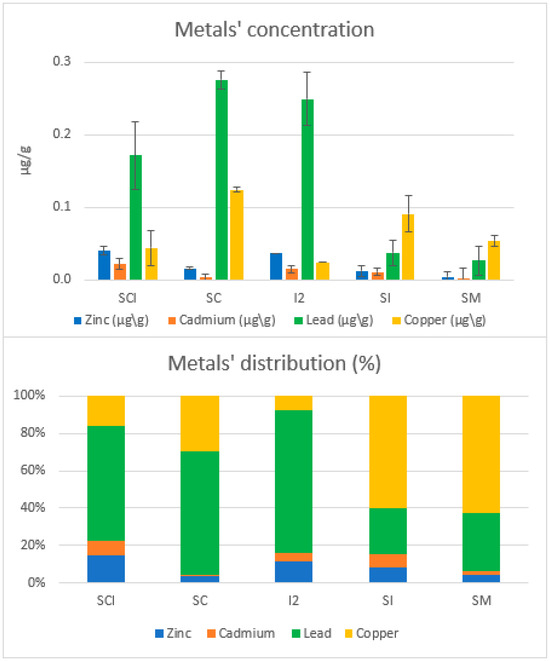
Figure 12.
Metal concentrations (top) and metal distribution (%) (bottom) from SCI, SC, SI, I2 and SM spots.
This result agrees with the observation that, due to their positions, these sampling points can be considered less affected by the smoke emitted during incense burning at the church entrance, differently from SCI, SC and I2. Overall, the most represented metals are lead and copper, the first one mostly being related to the intense vehicular traffic characterizing the area in the latter decades of the 20th century. Sample SC presents the highest concentration of the two (0.275 ± 0.012 µg/g for lead and 0.125 ± 0.003 µg/g for copper).
Differences can be observed in metal distribution: samples SCI, SC and I2 are characterized by a great contribution in terms of lead, zinc and cadmium (Figure 12 bottom); as reported in other published papers [37], these elements are strictly correlated to incense burning more than copper, presenting the greatest concentrations in samples SI and SM, as discussed before.
Comparing these results, we can conclude that all these samples are affected by road emission, but for samples SCI, SC and I2, the contribution of incense burning caused an increase in the amount of metals and variation in their distribution.
3.4. Biological Analyses
The molecular analysis revealed the presence of two biodeteriogen microorganisms, a prokaryote and a eukaryote (Figure 4). The first one is a bacterial organism belonging to the Clostridium genus (Clostridium sp.), homogeneously present in every single collected sample. Clostridium sp. is a Gram-positive lipolytic bacterium and an obligate anaerobe, like all other organisms of the Clostridiales family. As a sporigen bacterium, it is able to endure adverse conditions by releasing spores, making it able to withstand contact with oxygenated air. Members of the Clostridium genus are basically ubiquitarian, as they can be isolated from both soils and water, as well as walls and the human gut, and they are therefore not surprisingly one of the most frequently isolated organisms from urban surfaces [39]. The presence of strains belonging to the Clostridium genus might also be related to the very low concentration of sulphates found in some of the samples; such is the example of sample C6, featuring a modest concentration of 2.715 ± 0.035 mg/g. This can be explained by the well-documented biological activity of dissimilatory sulphate reduction, very common in the Clostridium genus [40]; these organisms use sulphates as final electron acceptors under anaerobic conditions, reducing sulphate to sulphide.
Aspergillus (100% matched identity in GenBank with JQ409277 Aspergillus sp.), a genus of black meristematic fungi, was found in samples C4 and C6, alongside Clostridium sp. (100% with FM211942 Clostridium sp.). This group of organisms, whose presence is often associated with conspicuous black patinas and crusts, are among the most common fungal biodeteriogens [41]. As other Hyphomycetes, Aspergillus sp. lacks the sexual structures known as fruiting bodies, typically used for their systematic classification, and are therefore defined as asexual or imperfect. They mainly reproduce through germination, releasing spores with two different mechanisms of fragmentation: one involving vegetative hyphae and another one involving the presence of specialized ones known as conidiophores. The spores of Aspergillus sp. are very volatile, and they can easily spread from one place to another, growing wherever the conditions are suitable. They usually grow on stone walls affected by heavy moisture infiltration (A. niger) [42], and due to this, the decorations of the church’s façade constitute a microenvironment prone to similar biodeterioration phenomena.
Not only are the species of the genus Aspergillus involved in the chromatic alteration in many forms of cultural heritage, from canvas to stonework, but they are also able to secrete a variety of organic acids [43], such as oxalic, formic and acetic acid, which may contribute to the degradation of substrates both directly, through pH alteration, and indirectly, by chelating various metal species.
4. Conclusions
This multifaceted overview of degradation processes and their direct and indirect causes, made possible by the wide array of diagnostic techniques employed, sheds light on the mosaic of complex conditions and interactions threatening the conservation of cultural heritage in urban contexts. The kind of investigation discussed herein presents many difficulties and challenges, starting from sampling to the interpretation of the results. As an example, the collection of black crusts is generally performed by detaching them from marble surfaces; this means that in many cases, there is contamination from the substrate, thus leading to uncertainty in the weight estimation of the samples. In addition, very small quantities of samples are usually collected; this implies that there are limitations on the achievable determinations. The experimental results indicate that there is great variability in the chemical composition of samples, even if they come from the same site due to the presence of specific sources (guano, microbial activities and surface heterogeneity, among others); this implies that the identification of sources contributing to this phenomenon is difficult. Nevertheless, the relevance of these studies is unquestionable: the complete characterization of deposits allows for the suggestion of better restoration strategies to apply; it also allows for a comparison of the efficiency of different restoration strategies depending on the deposits’ chemical compositions.
The outdoor, non-confined position of stonework, like the statues and emblem comprising the decorations of the façade of the “Gesù Nuovo” Church, represents, in and of itself, one of the main threats to the integrity of artefacts. Being subjected to adverse weather conditions, like rain, strong winds and salty breezes, increases mechanical stress and the risk of erosion for stone materials. Additionally, the still relevant and intense use of domestic heating, as well as other types of combustion (incense burning, biomass burning, vehicular traffic) in such a densely inhabited area, continues to represent a very dangerous source of chemical pollutants, spreading in the troposphere and finally depositing on the surface of walls.
The effects of these processes are clearly recognizable in the chemical composition of the deposits collected from the façade and from the portal of the Gesù Nuovo Church, characterized by the presence of sulphate (due to atmospheric pollution inducing the sulphation process), hydrocarbons (derived from different types of anthropic activities) and metals (due to both vehicular traffic and incense burning). The distribution of these species on the church façade is strictly connected to the distance from emission sources: hydrocarbons present higher concentrations in the lowest sampling point depending on the direct impact of vehicular traffic (principally, due to the presence of a parking area nearby); metals and some carboxylic acids such as oxalate present higher concentrations in some points of the portal due to the presence of a source point such as that of incense burning. Confronting these data with the biological survey highlighted how some heterotrophic organisms thrive in this these chemical microenvironments, also influencing the distribution of chemical species itself, such as in the case of Clostridium sp. in low-sulphate samples. The results discussed herein confirm the relevance of these types of investigations on the chemical composition of black crusts for both the choice of better diagnostic investigations and restoration strategies and the identification of emission sources acting on a site over time (from this point of view, black crusts may be considered supplementary indicators of the effects of air pollution in urban areas).
The detailed characterization of black crusts can constitute the basis for suggesting specific emission control strategies (as an example, changes in traffic patterns and the institution of pedestrian areas) and can act as a useful tool for indicating better conservation strategies to consider (also addressing research on new consolidating materials able to avoid the deposition of specific classes of substances).
Finally, we highlight that the effects discussed herein were generated over a relatively limited period, considering that there is evidence of a previous restoration intervention twenty years before, thus indicating the great pressure exerted by atmospheric pollutants.
Author Contributions
Conceptualization, E.C. and M.R.V.; data curation, E.C., P.C. and A.D.R.; formal analysis, E.C.; methodology E.C. and M.R.V.; investigation, E.C., M.R.V., G.T., C.S., P.C. and A.D.R.; writing-original draft preparation, E.C., M.R.V., J.R., G.T., C.S., P.C. and A.D.R.; writing—review & editing; E.C., P.C. and A.D.R. All authors have read and agreed to the published version of the manuscript.
Funding
This research received no external funding.
Institutional Review Board Statement
Not applicable.
Informed Consent Statement
Not applicable.
Data Availability Statement
The raw/processed data required to reproduce these findings cannot be shared at this time as the data also forms part of an ongoing study.
Acknowledgments
This work was conducted within the framework of the agreement between the Department of Science and Technology of Parthenope University of Naples and the Superintendency of Naples. The authors are grateful to the officials of the Superintendency: Architect E. Di Crescenzo and A. D’Alconzo and A. Cuccaro for providing access to the restoration site of “Gesù Nuovo” Church.
Conflicts of Interest
The authors declare no conflict of interest.
References
- Timoncini, A.; Brattich, E.; Bernardi, E.; Chiavari, C.; Tositti, L. Safeguarding outdoor cultural heritage materials in an ever-changing troposphere: Challenges and new guidelines for artificial ageing test. J. Cult. Herit. 2023, 59, 190–201. [Google Scholar] [CrossRef]
- Sicard, P.; Agathokleous, E.; Anenberg, S.C.; De Marco, A.; Paoletti, E.; Calatayud, V. Trends in urban air pollution over the last two decades: A global perspective. Sci. Total Environ. 2023, 858, 160064. [Google Scholar] [CrossRef] [PubMed]
- Harrison, R.M. Secondary pollutants. In Handbook of Air Pollution Analysis; Harrison, R.M., Perry, R., Eds.; Springer: Dordrecht, The Netherlands, 1986. [Google Scholar] [CrossRef]
- Singh, A.; Agrawal, M. Acid rain and its ecological consequences. J. Environ. Biol. 2008, 29, 15–24. [Google Scholar]
- Saiz-Jimenez, C.; Hermosin, B. Black crusts in the European built environment. Corros. Rev. 2004, 22, 381–394. [Google Scholar] [CrossRef]
- Ricciardi, M.; Faggiano, A.; Pironti, C.; Motta, O.; Carotenuto, M.; Comite, V.; Fermo, P.; Proto, A. Analysis of PAHs (polycyclic aromatic hydrocarbons) and other main components in black crusts collected from the Monumental Cemetery of Milan (Italy). J. Phys. Conf. Ser. 2022, 2204, 12027. [Google Scholar] [CrossRef]
- Warscheid, T.; Braams, J. Biodeterioration of stone: A review. Int. Biodeterior. Biodegrad. 2000, 46, 343–368. [Google Scholar] [CrossRef]
- Jain, A.; Bhadauria, S.; Kumar, V.; Chauhan, R.S. Biodeterioration of sandstone under the influence of different humidity levels in laboratory conditions. Build. Environ. 2009, 44, 1276–1284. [Google Scholar] [CrossRef]
- Alves, C.; Figueiredo, C.A.M.; Sanjurjo-Sánchez, J.; Hernández, A.C. Effects of water on natural stone in the built environment—A review. Geosciences 2021, 11, 459. [Google Scholar] [CrossRef]
- Sikiotis, D.; Kirkitsos, P. The adverse effects of nitrates on stone monuments. Sci. Total Environ. 1995, 171, 173–182. [Google Scholar] [CrossRef]
- Snethlage, R.; Sterflinger, K. Stone conservation. In Stone in Architecture; Siegesmund, S., Snethlage, R., Eds.; Springer: Berlin/Heidelberg, Germany, 2011. [Google Scholar] [CrossRef]
- Comite, V.; Pozo-Antonio, J.S.; Cardell, C.; Randazzo, L.; La Russa, M.F.; Fermo, P. A multi-analytical approach for the characterization of black crusts on the façade of an historical cathedral. Microchem. J. 2020, 158, 105121. [Google Scholar] [CrossRef]
- Maravelaki-Kalaitzaki, P. Black crusts and patinas on Pentelic marble from the Parthenon and Erechtheum (Acropolis, Athens): Characterization and origin. Anal. Chim. Acta 2005, 532, 187–198. [Google Scholar] [CrossRef]
- Pozo-Antonio, J.S.; Pereira, M.F.C.; Rocha, C.S.A. Microscopic characterisation of black crusts on different substrates. Sci. Total Environ. 2017, 584–585, 291–306. [Google Scholar] [CrossRef]
- Bellopede, R.; Ferrero, A.; Manfredotti, L.; Marini, P.; Migliazza, M. Thermal stresses. In Fracture and Failure of Natural Building Stones; Kourkoulis, S.K., Ed.; Springer: Dordrecht, The Netherlands, 2006. [Google Scholar] [CrossRef]
- Chianese, E.; Riccio, A. Long-term variation in exposure to NO2 concentrations in the city of Naples, Italy: Results of a citizen science project. Sci. Total Environ. 2024, 25, 172799. [Google Scholar] [CrossRef] [PubMed]
- Chianese, E.; Tirimberio, G.; Appolloni, L.; Dinoi, A.; Contini, D.; Di Gilio, A.; Palmisani, J.; Cotugno, P.; Miniero, D.V.; Dusek, U.; et al. Chemical characterisation of PM10 from ship emissions: A study on samples from hydrofoil exhaust stacks. Environ. Sci. Pollut. Res. 2022, 29, 17723–17736. [Google Scholar] [CrossRef]
- Chianese, E.; Tirimberio, G.; Dinoi, A.; Cesari, D.; Contini, D.; Bonasoni, P.; Marinoni, A.; Andreoli, V.; Mannarino, V.; Moretti, S.; et al. Ionic and Elemental Composition of Particulate Matter during the Winter Season: A Comparative Study among Rural, Urban and Remote Sites in Southern Italy. Atmosphere 2022, 13, 356. [Google Scholar] [CrossRef]
- Riccio, A.; Chianese, E.; Tirimberio, G.; Prati, M.V. Emission factors of inorganic ions from road traffic: A case study from the city of Naples (Italy). Transp. Res. Part D Transp. Environ. 2017, 54, 239–249. [Google Scholar] [CrossRef]
- Comite, V.; Fermo, P. The effects of air pollution on cultural heritage: The case study of Santa Maria delle Grazie al Naviglio Grande (Milan). Eur. Phys. J. Plus 2018, 133, 556. [Google Scholar] [CrossRef]
- Schiattarella, A.; Iappelli, F. Gesù Nuovo Edizione con Note; Edizioni Eidos: Bergamo, Italy, 1985. [Google Scholar]
- Morillas, H.; Maguregui, M.; Gallego-Cartagena, E.; Marcaida, I.; Carral, N.; Madariaga, J.M. The influence of marine environment on the conservation state of Built Heritage: An overview study. Sci. Total Environ. 2020, 745, 140899. [Google Scholar] [CrossRef] [PubMed]
- Winkler, A.; Contardo, T.; Lapenta, V.; Sgamellotti, A.; Loppi, S. Assessing the impact of vehicular particulate matter on cultural heritage by magnetic biomonitoring at Villa Farnesina in Rome, Italy. Sci. Total Environ. 2022, 823, 153729. [Google Scholar] [CrossRef]
- Ozgen, S.; Cernuschi, S.; Caserini, S. An overview of nitrogen oxides emissions from biomass combustion for domestic heat production. Renew. Sustain. Energy Rev. 2021, 135, 110113. [Google Scholar] [CrossRef]
- Duliu, O.G.; Emandi, A.; Marinescu, M.; Cinteza, O.; Stanculescu, I.; Ionescu, L.; Filimon, D. Assessing the degradation status of the imperial doors of the ascension church, Grindu Commune, Romania. Appl. Sci. 2024, 14, 7565. [Google Scholar] [CrossRef]
- Griffiths, P.R. Fourier transform infrared spectrometry. Science 1983, 222, 297–302. [Google Scholar] [CrossRef]
- Cennamo, P.; De Rosa, A.; Scielzo, R.; Rippa, M.; Trojsi, G.; Chianese, E. Diagnostic investigation of the wall paints conservative state in a hypogeal room of the archaeological park of Baia (Italy). Acta IMEKO 2024, 13, 1–8. [Google Scholar] [CrossRef]
- Chianese, E.; Tirimberio, G.; Riccio, A. PM2.5 and PM10 in the urban area of Naples: Chemical composition, chemical properties and influence of air masses origin. J. Atmos. Chem. 2019, 76, 151–169. [Google Scholar] [CrossRef]
- Manuals and Guidelines, ISPRA n. 75/2011. In Procedure of the Analysis of Hydrocarbons >C12 in Contaminated Soils; ISPRA—Istituto Superiore per la Protezione e la Ricerca Ambientale: Roma, Italy, 2011; ISBN 978-88-448-0523-4.
- U.S. EPA Method 3545, Pressurized Fluid Extraction. In Test Methods for Evaluating Solid Waste, 3rd ed.; Update III; U.S. EPA SW-846; U.S. Government Printing Office: Washington, DC, USA, 1995.
- Hongoh, Y.; Yuzawa, H.; Ohkuma, M.; Kudo, T. Evaluation of primers and PCR conditions for the analysis of 16S rRNA genes from a natural environment. FEMS Microbiol. Lett. 2003, 221, 299–304. [Google Scholar] [CrossRef]
- Countway, P.D.; Gast, R.J.; Savai, P.; Caron, D.A. Protistan diversity estimates based on 18S rDNA from seawater incubations in the western north Atlantic. J. Eukaryot. Microbiol. 2005, 52, 95–106. [Google Scholar] [CrossRef] [PubMed]
- Nawawi, O.; Abdullah, M.P.; Yusuf, C.Y.L. A strategy for in-house production of a positive selection cloning vector from the commercial pJET1.2/blunt cloning vector at minimal cost. Biotech 2022, 12, 216. [Google Scholar] [CrossRef] [PubMed]
- Koob, S.P. The use of Paraloid B-72 as an adhesive: Its application for archaeological ceramics and other materials. Stud. Conserv. 1986, 31, 7–14. [Google Scholar] [CrossRef]
- Keene, W.C.; Pszenny, A.A.P.; Galloway, J.N.; Hawley, M.E. Sea-salt corrections and interpretation of constituent ratios in marine precipitation. J. Geophys. Res. 1986, 91, 6647. [Google Scholar] [CrossRef]
- Hawley, M.E.; Galloway, J.N.; Keene, W.C. Standard error calculations for non-seasalt constituents in marine precipitation. Water Air Soil Pollut. 1988, 42, 87–102. [Google Scholar] [CrossRef]
- Zhang, Q.; Mao, H.; Zhang, Y.; Wu, L. Characterization of PM-Bound Heavy Metal at Road Environment in Tianjin: Size Distribution and Source Identification. Atmosphere 2021, 12, 1130. [Google Scholar] [CrossRef]
- Fang, G.C.; Chang, C.N.; Chu, C.C.; Wu, Y.S.; Fu, P.P.C.; Chang, S.C.; Yang, I.L. Fine (PM2.5), coarse (PM2.5–10), and metallic elements of suspended particulates for incense burning at Tzu Yun Yen temple in central Taiwan. Chemosphere 2003, 51, 983–991. [Google Scholar] [CrossRef]
- Bruggemann, H.; Gottschalk, G. Clostridia: Molecular Biology in the Post-Genomic Era; Caister Academic Press: Wymondham, UK, 2009. [Google Scholar]
- Campbell, L.L.; Postgate, J.R. Classification of the spore-forming sulfate-reducing bacteria. Bacteriol. Rev. 1965, 29, 359–363. [Google Scholar] [CrossRef] [PubMed]
- Krijsheld, P.; Bleichrodt, R.; van Velus, G.J.; Wang, F.; Müller, W.H.; Dijksterhuis, J.; Wösten, H.A.B. Development in Aspergillus. Stud. Mycrology 2013, 74, 1–29. [Google Scholar] [CrossRef] [PubMed]
- Carter, S.B.; Nokes, S.E.; Crofcheck, C.L. The influence of environmental temperature and substrate initial moisture content on Aspergillus niger growth and phytase production in solid-state cultivation. Trans. ASAE 2004, 47, 945–949. [Google Scholar] [CrossRef]
- Romero, S.M.; Giudicessi, S.L.; Vitale, R.G. Is the fungus Aspergillus a threat to cultural heritage? J. Cult. Herit. 2021, 51, 107–124. [Google Scholar] [CrossRef]
Disclaimer/Publisher’s Note: The statements, opinions and data contained in all publications are solely those of the individual author(s) and contributor(s) and not of MDPI and/or the editor(s). MDPI and/or the editor(s) disclaim responsibility for any injury to people or property resulting from any ideas, methods, instructions or products referred to in the content. |
© 2025 by the authors. Licensee MDPI, Basel, Switzerland. This article is an open access article distributed under the terms and conditions of the Creative Commons Attribution (CC BY) license (https://creativecommons.org/licenses/by/4.0/).